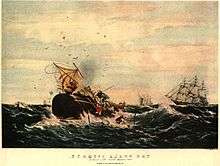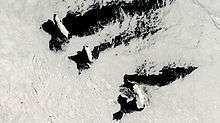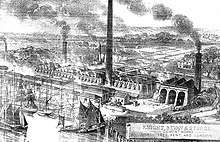Thomas Sturge
Thomas Sturge (1787-1866) was a British oil merchant, shipowner, cement manufacturer, railway company director, social reformer and philanthropist.
Thomas Sturge junior | |
|---|---|
| Born | 13 July 1787 Southwark St John Horsleydown, Bermondsey, London |
| Died | 14 April 1866 Northfleet, Kent |
| Nationality | British |
| Occupation | Whaler, shipping owner, cement manufacturer |
| Years active | 1800-1866 |
Notable work | philanthropist |
Family background and early life
Thomas Sturge was born in 1787, one of at least ten children of Thomas Sturge the elder (1749-1825), tallow chandler and oil merchant of Newington Butts, about a mile south of London Bridge. Thomas the younger joined his father's business early in the 19th century, as did at least three of his brothers, Nathan, George and Samuel. Thomas Sturge & Sons, oil merchants and spermaceti processors operated from premises near Elephant and Castle, Newington Butts, until 1840.[1]
He was a first cousin of social reformer and philanthropist Joseph Sturge.
Oil merchant and shipowner

Thomas Sturge junior had become the senior partner in the business by 1816, when he began to buy ships and send them to the Southern Whale Fishery to obtain whale oil, seal oil and spermaceti for processing and sale in London.[2] He became the principal owner of at least 23 vessels, most of them South Sea whalers.[3]
His Quaker faith and values were reflected in his business dealings. He tried to choose committed Christians to command his whale ships and in his sailing instructions gave his captains detailed advice on how to treat their crewmen.[4] His vessels each seem to have been supplied with a small library and at least five of his vessels carried a "surgeon" or ship's doctor.[5] One of these was Dr Thomas Beale who later wrote, The Natural History of the Sperm Whale (1839), which he dedicated to his employer.[6] Herman Melville drew on the book for his novel Moby Dick (1851).[7] The book also inspired three paintings of whaling scenes by J.M.W. Turner, exhibited at the Royal Academy in 1845 and 1846.[8] Turner tried to sell them to his patron, oil merchant, shipowner and art collector Elhanan Bicknell. Bicknell was an associate and friend of Sturge at Newington Butts.[9]
Social reformer and philanthropist
Sturge was a member of a committee to assist “distressed seaman” by 1818.[10] His firm donated £15 15 shillings in 1821 toward the cost of a suitable vessel to serve as a floating hospital for the “assistance and relief of sick and helpless seamen.”[11] The Seamen's Hospital Society was established that year, with William Wilberforce as one of the many vice presidents; Sturge was one of a couple of dozen men on its management committee, along with Zachary Macaulay and Captain William Young.[12]
He was a member of the Anti-Slavery Society and substantial financial contributor to the cause.[13] Another member of the society was the historian and politician Thomas Babington Macaulay (1800-1859) who became friends with Sturge. There were many Quakers in the abolition movement. Among these was his cousin the prominent anti-slavery abolitionist and philanthropist Joseph Sturge (1793-1859).
Thomas also made regular donations to a range of other charitable causes.[14] He provided transport to missionaries going to the South Seas on his whaling ships. Robert Moffat and his wife left their children in the care of Sturge and his invalid sister when they were in South Africa in the 1860s.[15] Thomas or his father, Thomas senior, was supporting the education of the deaf by May 1821.[16]
Contributor to Antarctic exploration

In 1838 Sturge joined a group of London shipowners to purchase two vessels, the schooner Eliza Scott (154 tons) and the cutter Sabrina (54 tons). These were sent to the Antarctic, under the overall command of Captain John Balleny, to search for undiscovered offshore islands that might host seal colonies that could be harvested.[17] Among the discoveries made was a cluster of five previously unknown islands. They were given the collective name of the Balleny Islands with individual islands named after those who had funded the expedition. Sturge Island is 23 miles long and 6 miles wide and permanently covered in a mantle of snow and ice.
Cement producer

In 1837 and 1838 he purchased two adjacent blocks of land on the Thames near Northfleet at a cost of £9,313.[18] On that 74 acre plot he built a cement works to make Portland cement. Construction of the cement kilns started in 1851 and production began in 1853.[19]
Railway investments
He was interested in the building of new railways and in 1842 he spoke at a public meeting in favour of the construction of the Dean Forest and Gloucester railway line.[20] He became a significant shareholder in the Eastern Union Railway Company and a major shareholder and director of the West Hartlepool Harbour and Railway Company.[21]
Later life
In 1842 he left London and moved downriver to Northfleet, where he had purchased Northfleet House, a mansion under construction, for £3900.[22] Thomas Sturge the younger died there on 14 April 1866.[23] He never married and most of his estate, valued at about £180,000, was left to his brother and business partner, George.[24]
Notes
- London Metropolitan Archives, index to the records of the Sun Fire Assurance Office, 1840.
- "British Southern Whale Fishery - Voyages". bswf.hull.ac.uk.
- Howard, p.414.
- Howard, p.433.
- Howard, p.425.
- Thomas Beale, The Natural History of the Sperm Whale, London, John Van Voorst, 1839; reprinted by The Holland Press, London, 1973, p.ix-x.
- Howard P. Vincent, The trying-out of Moby Dick, Houghton Miffin, Boston, 1949, p.128.
- Beale (1973) dustjacket.
- Philip Hoare, (2009) Leviathan or, the whale, London, Fourth Estate, p.250-1, 277. ISBN 978-0007230143
- Morning Chronicle, 9 January 1818.
- Morning Chronicle, 15 March 1821.
- The annual subscription charities and public societies in London. 1823. p. 24. Retrieved 28 April 2018.
- Anti-Slavery Monthly Reporter, 3, June 1829-December 1830, p.268; William Lloyd Garrison, The letters of William Lloyd Garrison; No union with the slaveholders, 1841-1849, Cambridge, MA, 1974, p.187.
- Jones, p.480; "The Times, 3 May 1826 & 10 June 1823.
- Letter from Robert Moffatt dated 22 June 1861 to Thomas Sturge. Cambridge University Library, Add Ms8830 3/2/101.
- List of Governors and officers of the asylum for the support and education of the deaf and dumb children of the poor, London, 1821, p.175.
- "Discoveries in the Antarctic Ocean, in February 1839. Extracted from the Journal of the schooner Eliza Scott, commanded by Mr John Balleny, communicated by Charles Enderby, Esq., Journal of the Royal Geographical Society of London, 9 (1839) pp.526-7.
- British Parliamentary Papers, HC 1842, Vol 25, p.26.
- "Cement Kilns: Bevans".
- Berrows Worcestor Journal, 15 December 1842.
- Sturge v Eastern Union Railway Co., 2 May - 2 June 1855, Hein online Legal Database, 7 DE G.M. & G. 162; House of Lords Sessional Papers, 1863, Vol.XXXIV, p.58.
- Howard, p.423.
- Entry for Thomas Sturge, England & Wales National Probate Register, 1858-1966.
- A.J. Francis, The cement industry, 1796-1914: a history, Newton Abbott, 1978, p.165.
Further reading
- British Southern Whale Fishery, web site, http://www.britishwhaling.org/
- Howard, Mark, “Thomas Sturge and his fleet of South Sea whalers,” International Journal of Maritime History, 27 (3) August 2015, 411-433.
- Jones, A.G.E. (1986). Ships employed in the South Seas Trade 1775-1861. Canberra: Roebuck. ISBN 978-0909434304.